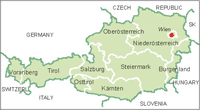
Vienna
About Vienna
 Settlements along the Danube, near what is now the City of Vienna, can be traced back to the 5th century before Christ. These were of Celtic origin as is the name Wien derived from the Celtic "Vedunia" for river in the woods. The Romans established the garrison camp Vindobona in the 1st century A.D. Remainders of the Roman camp can be seen at Hoher Markt and at underground station Stephansplatz. Vienna began to rise in importance in the Middle Ages. It was made residence of the Babenbergs and the city walls were raised in 1200. Vienna was to become the capital of the Habsburg empire for almost seven centuries. Its imperial past is still visible today, as with the Hofburg, Schnbrunn castle, the buildings along Ringstrasse and many other sites throughout the city.
Settlements along the Danube, near what is now the City of Vienna, can be traced back to the 5th century before Christ. These were of Celtic origin as is the name Wien derived from the Celtic "Vedunia" for river in the woods. The Romans established the garrison camp Vindobona in the 1st century A.D. Remainders of the Roman camp can be seen at Hoher Markt and at underground station Stephansplatz. Vienna began to rise in importance in the Middle Ages. It was made residence of the Babenbergs and the city walls were raised in 1200. Vienna was to become the capital of the Habsburg empire for almost seven centuries. Its imperial past is still visible today, as with the Hofburg, Schnbrunn castle, the buildings along Ringstrasse and many other sites throughout the city.
The fall of the monarchy proved a turning point in the history of Vienna. In 1922 Vienna was made a province in its own right. ... (more)
Tourist attractions
 Vienna is framed by the hills of the Vienna Woods in the West and - at least the historic parts - by the Danube in the East. Other important landmarks are the Donaukanal and the Alte Donau, old Danube River beds.
Vienna is framed by the hills of the Vienna Woods in the West and - at least the historic parts - by the Danube in the East. Other important landmarks are the Donaukanal and the Alte Donau, old Danube River beds.
Best Attractions of Vienna, among many others, are:
1.) Schoenbrunn Palace
2.) Belvedere Palace & Austrian National Gallery
3.) Museumsquartier: District of Museums
4.) Kunsthistorisches Museum (Art History)
5.) Ringstrasse Road: 19th century boulevard
6.) Stephansdom Cathedral
7.) Hofburg: Treasury, National Library, Albertina
8.) Staatsoper National Opera & Burgtheater
9.) The Prater
... (more)
 Back to top
Back to top


 Romana
Romana English
English











